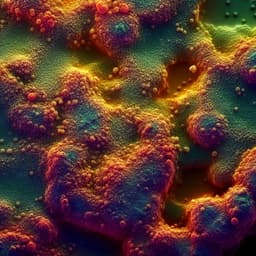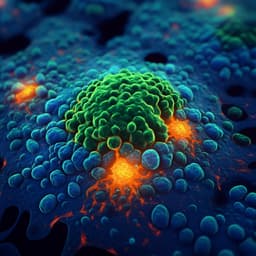
Environmental Studies and Forestry
Advanced sludge treatment affects extracellular polymeric substances to improve activated sludge dewatering
E. Neyens, J. Baeyens, et al.
Explore the innovative findings from researchers Elisabeth Neyens, Jan Baeyens, Raf Dewil, and Bart De heyder on wastewater sludge management. This paper highlights how advanced sludge treatment processes enhance dewaterability by tackling the challenges posed by extracellular polymeric substances, ultimately leading to improved flocculation and reduced water retention.
~3 min • Beginner • English
Introduction
Biological wastewater treatment is effective but produces large amounts of excess sludge, making sludge handling a major cost and technical challenge in wastewater treatment. Dewatering is often the bottleneck step. Advanced sludge treatment (AST) processes—thermal hydrolysis (neutral, acid, alkaline) and chemical oxidation (e.g., H2O2)—have been developed to improve dewaterability and disposal. Because microorganisms in sludge are embedded in extracellular polymeric substances (EPS), which strongly affect water retention, bioflocculation, settling, and dewatering, understanding how AST affects EPS is critical. This paper reviews EPS characteristics and assesses mechanisms and results of AST processes with experimental verification on municipal waste activated sludge.
Literature Review
EPS are complex matrices of polysaccharides, proteins, nucleic acids, lipids, and other polymers forming a hydrated gel that can account for up to 80% of activated sludge mass. Early work emphasized polysaccharides, but many studies reported proteins as predominant in activated sludge EPS, likely due to exoenzymes and wastewater complexity. EPS bind significant water via electrostatic interactions (notably carboxylate and hydroxyl groups) and hydrogen bonds, hampering dewatering. Literature shows conflicting EPS effects on dewaterability: low to moderate EPS may enhance flocculation and dewatering by reducing fines, but excess EPS impairs dewaterability due to bound water. Water-binding in EPS can be disrupted by treatments (e.g., chlorine in FTIR-ATR studies). Thermal conditioning improves dewatering and solubilizes organics (proteins, carbohydrates, lipids), producing amino acids, volatile acids, and sugars, with protein denaturation implicated. Acids/alkalis catalyze thermal hydrolysis; acids hydrolyze glycosidic linkages, and strong alkali can solubilize gels via ionization and swelling. Extreme pH also disrupts cells, releasing intracellular water. Advanced oxidation (Fenton chemistry) generates hydroxyl radicals that depolymerize extracellular polymers via oxidative-reductive depolymerization (ORD), achieving high depolymerization rates at ambient conditions and preferentially degrading extracellular matrix over cells. pH influences surface charge and floc stability: near the isoelectric point (pH ~2.6–3.6), electrostatic repulsion is minimized, improving flocculation; at high pH, increased negative charge can desorb polymers which may act as polyelectrolytes enhancing flocculation. Divalent cations (e.g., Ca2+, Mg2+) bridge negative sites on biopolymers, binding primarily protein, improving floc size, density, and dewaterability.
Methodology
Sludge source: Thickened waste activated sludge (≈6% dry solids, DS) from the municipal sewage treatment plant of Kessel-Lo (Leuven, Belgium). AST processes evaluated included: thermal hydrolysis (neutral), acid thermal hydrolysis (with H2SO4), alkaline thermal hydrolysis, and peroxidation (Fenton’s reagent: H2O2 with Fe2+), studied at lab, semi-pilot, and pilot scales. Operating conditions were optimized based on prior work; representative optimal conditions included: thermal hydrolysis at 120°C, 60 min; acid thermal hydrolysis at 120°C, pH 3, 60 min; alkaline thermal hydrolysis at 100°C, pH 10, 60 min; peroxidation at ambient temperature and pressure, pH 3, H2O2 ≈2.5 g/kg DS, Fe2+ ≈1.67 g/kg DS, 60–90 min. Dewaterability was assessed via capillary suction time (CST), percentage DS in dewatered cake, and fraction of DS remaining to be dewatered relative to untreated sludge. EPS component degradation was inferred by measuring total sludge proteins and polysaccharides (as proxies for EPS components): proteins by a modified Lowry method using bicinchoninic acid (BCA) standard; polysaccharides by the anthrone method (glucose standard). Particle size distribution to assess flocculation was measured using a Malvern Mastersizer laser diffractometer (5–300 µm range), reporting d10, d50, d90 percentiles. Additional observations included release of heavy metals to the filtrate upon EPS degradation. An economic assessment was conducted for a 300,000 equivalent-inhabitant (IE) WWTP with sludge dewatering and incineration, assuming sludge production of 60 g DS/IE·d (annual 6570 t DS), comparing traditional operation costs with AST peroxidation (capital annualization over 10 years, maintenance, chemical and electricity costs, and disposal costs).
Key Findings
- Thermal hydrolysis (120°C, 60 min): decreased rate of mechanical dewatering as measured by CST, reduced DS to be dewatered to 58% of untreated, increased cake solids from 30% to ≈43% DS. Solubilization evidenced by increased water-phase COD; formation of amino acids, volatile acids, and sugars. Proteins denatured by heat.
- Acid thermal hydrolysis (H2SO4, 120°C, pH 3, 60 min): increased dewatering rate (CST improved); DS to be dewatered reduced to 45% of untreated; cake ≈45% DS (from 25% initial). Enhanced degradation of EPS via acid-catalyzed hydrolysis.
- Alkaline thermal hydrolysis (100°C, pH 10, 60 min): increased dewatering rate (CST improved); DS to be dewatered reduced to 62% of untreated; cake ≈48% DS (from 28% initial). Alkali promotes gel solubilization and cell disruption.
- Peroxidation (ambient T,P; pH 3; H2O2 ≈2.5 g/kg DS; Fe2+ ≈1.67 g/kg DS; 60–90 min): ≈30% reduction of DS and ODS during treatment; increased dewatering rate (CST improved); DS to be dewatered ≈40% of untreated; cake ≈45% DS (from 27% initial untreated in pilot setup). Hydroxyl radicals degrade EPS via ORD.
- EPS component degradation (proteins/polysaccharides as % of DS): untreated proteins 36.2%, polysaccharides 22.4%. After treatment: thermal hydrolysis proteins 30.1%, polysaccharides 20.7%; acid thermal proteins 25.7%, polysaccharides 19.3%; peroxidation proteins 24.3%, polysaccharides 18.5%. Total destruction of proteins+polysaccharides: ≈13% (thermal), ≈23% (acid thermal), ≈27% (peroxidation). Proteins more degraded than polysaccharides.
- Floc size distribution (µm; d10/d50/d90): untreated 32.82/106.64/169.47. Thermal hydrolysis 34.92/65.99/117.36 (overall reduction in floc sizes). Acid thermal 54.88/106.93/169.57; alkaline thermal 58.46/105.24/209.16; acid at ambient 64.06/121.36/193.48; alkaline at ambient 66.07/125.13/226.77; peroxidation 47.38/91.83/161.47. Acidic/alkaline conditions increase small-floc sizes (d10), indicating improved aggregation; peroxidation increases d10 notably while slightly reducing d50/d90.
- pH effects: Near pH 2.6–3.6 (isoelectric range), electrostatic repulsion is minimized, favoring flocculation. High pH increases negative surface charge; desorbed polymers and cell lysis products can act as polyelectrolytes to promote flocculation.
- Cation effects: Divalent cations (e.g., Ca2+, Mg2+) bridge negative sites on exocellular biopolymers, primarily binding proteins, improving settling and dewatering.
- Heavy metals: EPS degradation releases significant amounts of heavy metals to the water phase (filtrate), necessitating precipitation and separation before recycle to plant influent.
- Economic assessment (300,000 IE plant; 6570 t DS/year): Traditional operation annualized cost ≈1.9 M EUR. AST peroxidation: fixed equipment ≈50,000 EUR/yr, maintenance ≈10,000 EUR/yr, chemicals and electricity ≈400,000 EUR/yr; total ≈460,000 EUR/yr (excluding disposal). Disposal charged at 72 EUR/ton sludge regardless of cake DS; peroxidation increases cake DS to ≈45%, reducing disposal cost per unit DS from ≈288 to ≈160 EUR/ton DS, yielding >800,000 EUR/yr savings on disposal. Net saving ≈340,000 EUR/yr (≈52 EUR/ton DS).
Discussion
The study demonstrates that AST technologies improve dewatering by directly targeting EPS, which are central to sludge structure and water retention. Degradation of EPS proteins and polysaccharides reduces bound water, enhancing cake dryness and decreasing the mass requiring dewatering. Concurrently, AST influences interparticle interactions: operating near the isoelectric pH and leveraging cation bridging promotes flocculation, reduces fine flocs that blind filters, and thereby improves filtration performance. Although pure thermal hydrolysis can reduce floc sizes (d50, d90), the net dewatering still improves due to substantial EPS degradation and cell disruption releasing interstitial water. Acid and alkaline conditions compensate for thermal floc breakdown by enhancing aggregation via charge neutralization or polyelectrolyte effects. Peroxidation emerges as particularly effective because hydroxyl radicals depolymerize EPS at ambient conditions, simultaneously improving small-floc aggregation (higher d10) and dewatering metrics, with favorable process economics at full scale. The linkage between improved dewaterability and reductions in EPS components, along with measured changes in particle size distributions under different ASTs, supports the hypothesis that EPS modification is the primary mechanism driving performance gains.
Conclusion
Advanced sludge treatment processes (thermal hydrolysis, acid/alkaline thermochemical treatments, and Fenton-based peroxidation) improve sludge dewatering and reduce solids requiring processing. Mechanistically, they: (i) degrade EPS proteins and polysaccharides, lowering water-retention capacity and releasing bound water; and (ii) enhance flocculation by modifying surface charge interactions (especially near pH 2.6–3.6) and enabling cation bridging, thereby reducing fine flocs that impede filtration. Experimental results showed greater EPS component destruction with acid thermal hydrolysis (~23%) and peroxidation (~27%) than with thermal hydrolysis (~13%), mirrored by improved dewatering metrics and favorable floc size distributions. Peroxidation, in particular, provided strong performance at ambient conditions and attractive economic savings in a 300,000 IE scenario. Overall, targeting EPS structure and interparticle interactions is an effective strategy to enhance activated sludge dewatering.
Limitations
- Sludge source and characteristics: Experiments used thickened waste activated sludge (~6% DS) from a single municipal WWTP, which may limit generalizability to other sludge types or industrial sludges with different EPS composition and cation profiles.
- Measurement scope: Particle sizing relied on a laser diffractometer with a 5–300 µm range and spherical particle assumption; flocs outside this range or nonspherical shapes may affect interpretations.
- Thermal hydrolysis effects: Although dewatering improved, thermal hydrolysis reduced floc sizes (d50, d90), potentially influencing downstream processes sensitive to floc structure.
- Filtrate quality: EPS degradation released heavy metals into the water phase, requiring additional precipitation and separation steps before recycle; this adds treatment complexity and cost.
- Process specifics: Reported optimal conditions (temperature, pH, reagent doses, reaction times) may vary with sludge characteristics; scale-up may necessitate site-specific optimization. Corrosion-resistant materials are required for peroxidation systems.
Related Publications
Explore these studies to deepen your understanding of the subject.







